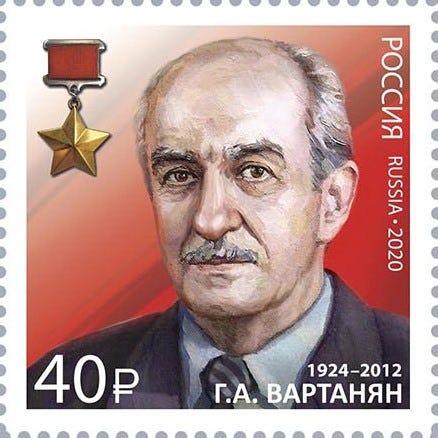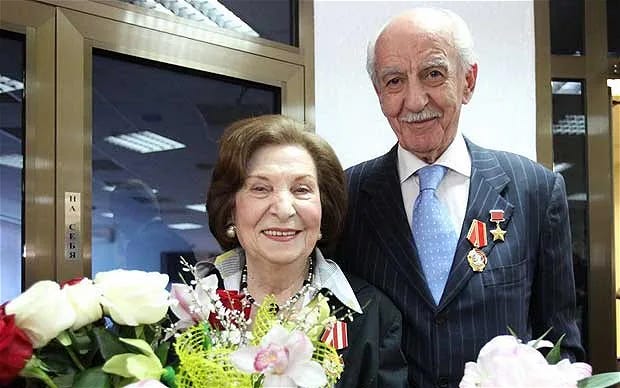Gevork Andreyevich Vartanyan - CODENAME - AMIR
Too bad he was a communist. This illegal's story is incredible.
Gevork Andreyevich Vartanian was a celebrated Soviet intelligence officer of Armenian descent, whose life reads like a Cold War spy novel. He dedicated over five decades to serving his country, operating in the shadows with remarkable skill and courage. Born on February 17, 1924, in Rostov-on-Don, USSR , Vartanyan's journey into the world of espionage began at an astonishingly young age, influenced by his father, Andrei Vartanian, a Soviet agent working undercover as a prosperous merchant in Persia (Iran) for 23 years .
Early Life and Entry into Intelligence
Vartanian entered the realm of intelligence at a mere 16 years old . In 1940, he was just a teenager when he connected with the Tehran residency of Soviet intelligence, working under the guidance of Ivan Agayants . Vartanian's Armenian heritage may have played a role in his early recruitment and his effectiveness in certain regions. The Armenian diaspora in Iran provided a potential network of contacts and a degree of cultural familiarity that could be invaluable for an intelligence operative.
In Tehran, Vartanian swiftly assembled a pro-Soviet group composed primarily of young individuals like himself . This group, later dubbed the "light cavalry" for their speed and agility, often utilizing bicycles for their operations, focused on identifying and neutralizing Nazi agents operating within Iran. Remarkably, this group, comprised of five Armenians, an Assyrian, and a Lezghin, reportedly exposed over 400 German agents between 1940 and 1941. However, their activities were detected by Iranian police in 1941, leading to Vartanian's brief imprisonment. This early encounter with the risks of espionage proved to be a formative experience, providing him with valuable lessons in clandestine operations that would serve him well in his future career.
Operation Long Jump
Vartanian's most lauded accomplishment came in 1943 during the Tehran Conference. At just 19, he played a critical role in thwarting Operation Long Jump, a daring Nazi plot to assassinate Joseph Stalin, Winston Churchill, and Franklin D. Roosevelt. This operation, personally sanctioned by Adolf Hitler and spearheaded by the infamous SS officer Otto Skorzeny, aimed to cripple the Allied war effort by eliminating its top leaders.
The initial warning about the plot came from Soviet intelligence agent Nikolai Kuznetsov, operating undercover in Nazi-occupied Ukraine. Kuznetsov, under the alias Paul Siebert (upcoming), cleverly extracted crucial information about the operation from an intoxicated SS officer, Ulrich von Ortel. While the precise timing of the operation remained unclear, the intelligence unequivocally confirmed the existence and imminent threat of the plot.
Vartanian's team, entrusted with the security of the Tehran Conference, diligently tracked down six Nazi radio operators who had been covertly parachuted near Qom, approximately 40 miles from Tehran. These operatives were equipped with communication devices and weapons, and Vartanian's team maintained constant surveillance, intercepting their radio transmissions to Berlin. Through meticulous decryption of these messages, Vartanian's team made a chilling discovery: the Germans were preparing to deploy a second group of operatives, led by Skorzeny himself, to execute the assassinations.
With the fate of the Allied leaders hanging in the balance, Vartanian's team acted decisively. They apprehended the first group of Nazi operatives and, under strict Soviet supervision, compelled them to continue communicating with their handlers. This ingenious tactic effectively disrupted the operation, misleading the Nazi command and preventing Skorzeny's team from reaching Tehran. Vartanian's quick thinking and bravery ensured the safety of the Allied leaders and the success of the Tehran Conference, a pivotal event that shaped the course of World War II.
Activities in Iran
Iran, with its strategic location and complex political landscape, served as a critical stage for espionage activities during World War II and the Cold War. Vartanian's early work in Tehran, including his involvement in Operation Long Jump, highlights the intensity of the intelligence struggle in this region. His wife, Goar, also played a significant role in their missions, working alongside him as a fellow intelligence officer. Their combined efforts contributed to the success of Soviet intelligence operations in Iran, a country that became a focal point for both Allied and Axis powers during the war.
Later Years and Continued Service
Following the war, Vartanian's career in espionage continued for three decades, taking him and his wife, Goar Levonovna, to various corners of the globe, including Japan, China, India, France, Italy, the United States (FOIA request denied), and West Germany. Their work often involved assuming deep cover, requiring them to marry and remarry multiple times in different locations to maintain their fabricated identities. This constant need for deception and the challenges of living under assumed identities undoubtedly placed a strain on their personal lives, but their commitment to their mission remained unwavering.
Vartanian's fluency in eight languages proved to be a valuable asset in his international espionage work. This linguistic proficiency allowed him to navigate diverse environments, gather intelligence from various sources, and blend seamlessly into different cultures. He further honed his skills as an intelligence officer by graduating from the Institute of Foreign Languages in Yerevan in 1955.
Vartanian's career was not without its challenges and vulnerabilities. As an illegal spy, he lacked diplomatic immunity, making him susceptible to arrest and prosecution if his true identity was discovered. The long periods spent operating in deep cover, with limited contact with headquarters, also increased the risk of defection or losing focus on the mission. Despite these risks, Vartanian remained dedicated to his service, demonstrating remarkable resilience and loyalty throughout his career.
Vartanian and Goar returned to the Soviet Union in 1986 and officially retired from active service in 1992 — just as their country was crumbling. However, Vartanian continued to contribute to the intelligence community by training young agents, passing on his extensive knowledge and experience to the next generation of spies. His work in Italy, mentioned in some sources, remains largely shrouded in secrecy, but it likely involved further deep-cover operations and intelligence gathering during the Cold War.
Recognition and Legacy
Vartanian's contributions to Soviet intelligence were formally recognized in 1984 when he was awarded the Hero of the Soviet Union medal. This prestigious award, the highest honor bestowed by the Soviet Union, acknowledged his bravery, unwavering dedication, and remarkable achievements in protecting his country's interests. He was also honored with the Order of Honor by Armenia in 2009 and a medal from Armenia's National Security Service in 2004. After his success in 1943, he received the Order of the Great Patriotic War, the Battle Red Banner, and the Red Star. He was also awarded the Order for Services to the Fatherland when he turned 80.
Vartanian's true identity and his pivotal role in thwarting Operation Long Jump remained a closely guarded secret until 2000 when he finally received public acknowledgement for his extraordinary feat. This revelation brought him international acclaim and cemented his place as a legendary figure in the annals of espionage. In 2007, he even met with Winston Churchill's granddaughter(!), who expressed her gratitude for his service in preventing the assassination plot that could have altered the course of history.
His life and career have been the subject of numerous books and films, including "Tehran-43 or Operation Long Jump" by Yuri Lvovich Kuznets and the Soviet-French film "Teheran 43" featuring Alain Delon. More recently, "Agent That Outsmarted Abwehr" by Khachik Khutlubyan was published as part of a series dedicated to the 100th anniversary of Russian foreign intelligence. Vartanian himself gave an interview about Operation Long Jump to Al Gurnov on the American cable show Spotlight, providing a firsthand account of this critical event.
Several memorials have been dedicated to Vartanian, including a monument at the Troekurovsky cemetery in Moscow, a nominal "Star" on the Avenue of Stars in Rostov-on-Don, and a memorial plaque at Yerevan State Linguistic University. These tributes reflect Russia’s continued aggrandizement of former illegals.
Controversies and Open Questions
Despite the widespread recognition of Vartanian's accomplishments, some controversies and unanswered questions persist regarding Operation Long Jump and the true extent of the Nazi threat in Tehran. Some historians have cast doubt on the veracity of the plot, suggesting that it may have been exaggerated or even fabricated by Soviet intelligence for political purposes. They argue that Stalin may have used the alleged plot to strengthen his position within the Allied forces and diminish Churchill's influence. Adding to the controversy, the alleged SS mastermind behind the operation later dismissed it as a figment of the imagination, further fueling skepticism about its authenticity.
However, Vartanian's own accounts and declassified documents provide substantial support for the existence of the plot and underscore his crucial role in averting a potentially disastrous outcome. The fact that the KGB attempted to secretly acquire three banks in northern California – Peninsula National Bank in Burlingame, the First National Bank of Fresno, and the Tahoe National Bank in South Lake Tahoe – to gain access to high-technology secrets during this period suggests that the Nazi threat was indeed real and that the Soviets were actively engaged in counterintelligence efforts.
Furthermore, an anecdote recounted by Yuri Lvovich Kuznets sheds light on the complex dynamics between the Allied leaders during the Tehran Conference. Stalin, observing that President Roosevelt had difficulty moving around due to his disability, reportedly pushed his wheelchair to the meeting table, a gesture that may have been calculated to foster closer ties with Roosevelt. This anecdote, while seemingly trivial, provides a glimpse into the political maneuvering and personal interactions that took place behind the scenes of this crucial wartime summit.
Ultimately, a definitive assessment of Operation Long Jump and its full implications requires further research and analysis of historical records. The controversies surrounding this event serve as a reminder of the complexities of espionage and the challenges of interpreting historical events in the context of Cold War rivalries and propaganda.
Conclusion
Vartanian's life was an extraordinary testament to his unwavering dedication to his country and his exceptional abilities as an intelligence officer. From his remarkable entry into espionage as a teenager to his pivotal role in thwarting Operation Long Jump and his continued service during the Cold War, Vartanian's career was characterized by bravery, resourcefulness, and an unwavering commitment to his mission. He faced the challenges and vulnerabilities inherent in the life of an illegal spy with remarkable resilience and loyalty.






